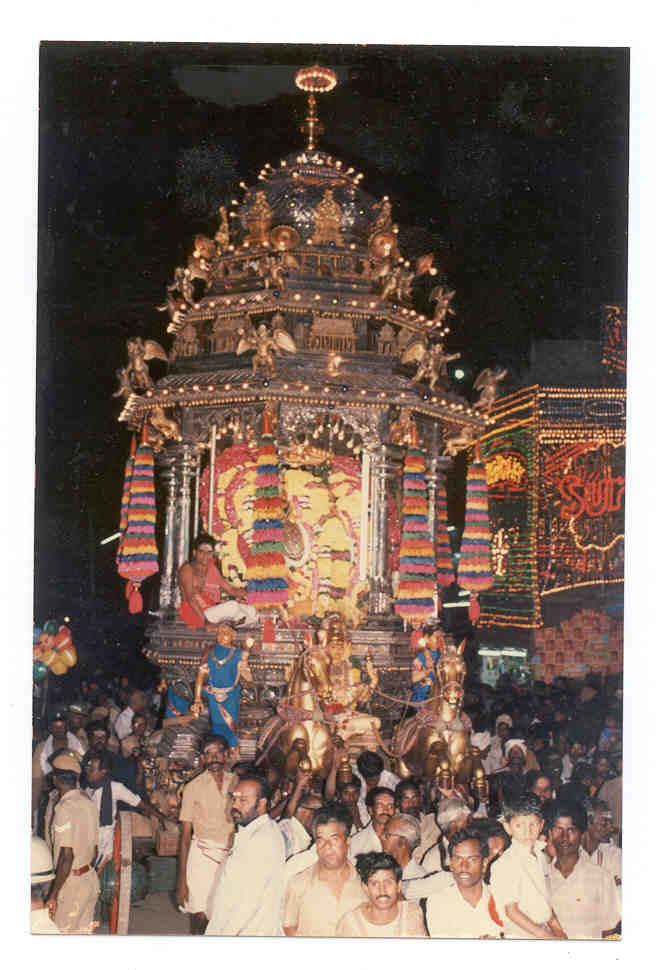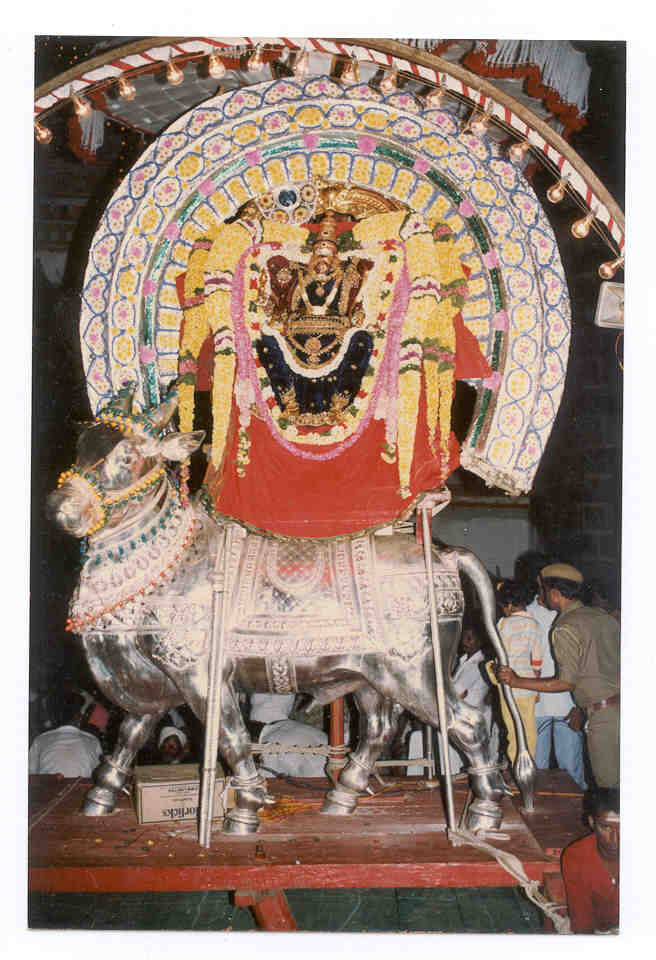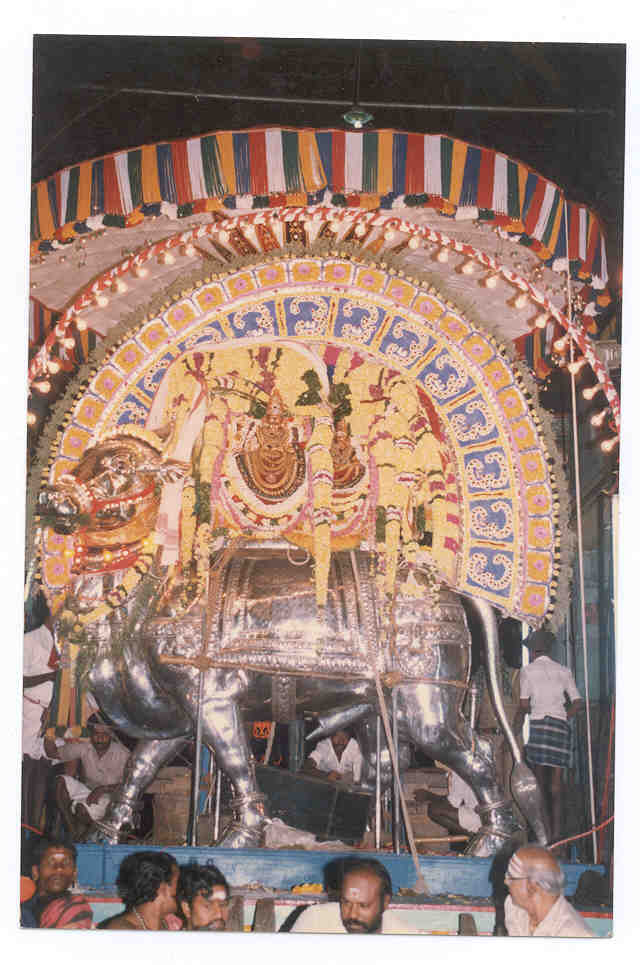 
Weekly Feature - Nov 26 1999
Previous Week
Abodes
of Shiva
Templenet Archives
Encyclopedia of Indian Temples
Indian Temple Architecture Travel and
Tourism
Festivals and Fairs
Legends and Beliefs
Glossary
Templenet - The Ultimate Source of
Information on Indian Temples
Links
of the Week
Tamilnadu Tourism
For more information, please contact:
webmaster@templenet.com
©1996 K. Kannikeswaran
All Rights Reserved.
Templenet
where
Tradition Meets Technology
|
|
Kartikai Peruvizha - A report on
the annual festival (Bhrammotsavam) at
Tiruvannamalai
by
C. Suresh
Foreword Inaugration Significance of
Veedhi Ula The Fifth Day The Silver Rishabha Vahanam
Festival The Silver Chariot Festival Chariot Festival
- Foreword:
The Arunachaleswarar Temple at Tiruvannamalai is one of the
grandest in India, and is considered to be among the most revered of the 275 Shiva Temples glorified by the Tamil Tevaram hymns of the 7th
through the 9th centuries. This temple has a great tradition of festivals, the Kartikai
Peruvizha being the grandest. Kartikai Deepam marks the
conclusion of the 10 day long festival in the Tamil month of Kartikai (Scorpio), a
festival that is marked by grand processions in which images of Annamalaiyaar
and Unnamulaiyaal are taken out on decorated mounts, through the processional streets
of Tiruvannamalai. This complex festival involving a multitude of festivites and hundreds
of thousands of participants happens with amazing regularity, each year - and can be
described as a case study in effective operations management. C. Suresh,
originally from Tiruvannamalai, currently stationed in Pune, India describes with
ample illustration, some of the features of this grand festival.
Inaugration: The festival starts on the
Panchami before Pournami (fifth day of the brighter half of the month of Kartikai
ie. Nov 15 - Dec 15) early in the morning with a brief flaghoisting ceremony
(Dwajaarohanam).From that day onwards for the next ten days,processional images of the
Panchamurthys comprising of Vinayakar, Subramanyar with his consorts, Lord
Somaskanda (the processional image of Annamalaiyaar) with his consort Devi and Skanda,
Goddess Appetha Kuchambal and Chandikeswarar are decorated with ornaments and
garlands carried out in procession through the main four streets (Raja Veedis)around the
temple twice a day in various vahanams (mounts) such as Karpaga Vriksham, peacock,
Kamadhenu,,silver Rishabham(Bull) , horse, Lion, swan, and in decorated chariots.
The entire procession can be classified into three parts. The first part involves
festivities inside the kalyana mandapam within the temple precincts where images of
the Panchamurthys are kept for this ten day period. The second part involves
processions inside the
temple complex on the way to temple entrance and the third the actual procession around
the
temple.(Veedhi Ula).
Significance of Veedhi Ula
These festivals have been in existence for several centuries. It is interesting to note
that they involved the participation of several sections of society - in creating a
magnificient visual treat, and a collossal parade involving much of the town and the
environs. Say for example the chariot festival would not be possible without the
collective efforts of the town's populace; for centuries, the mammoth chariot has been
pulled by human power alone without the aid of any modern devices that we take for granted
today. The entire town comes together to pull the chariot. So do an entire range of
artisans, depicting their skills in music, dance, garland making and so on and so forth.
Also, during the time of these festivities, merchants gather from far and wide to display
their wares.
Let us take a look at a few of the festivities involved in this 10 day festival.
Fifth day Morning Festival
During Fifth day morning Vigneswara and Lord Chandrasekara are taken out on the
Silver
mooshika vahanam and the silver small Rishaba vahanam around the temple..The temple
elephant deceorated with silk cloth leads the procession.Then follow the drummers. The
nadaswaram players follow the image of Vinayaka, while the utsavamoorthy Chandrasekharar
(processional image) decked in ornamental finery - the central point of the procession
follows. This is not the end of the procession. A group of priests reciting the
vedic hymns, and a group of Oduvaars singing the celebrated Tirumurai hymns follow. The
procession is accompanied by a sea of humanity, as it winds its way around the temple,
arriving back at the temple at around 1pm in the afternoon.
Fifth Night
Festival - Silver Rishabha Vahanam
In the first phase of the fifth night's festival, the pancha moorthis are decorated
with arnoments and flower garlands and are
readied for the festivities at around 8.30 pm. arnoments and flower garlands and are
readied for the festivities at around 8.30 pm.
Somaskandar is decorated with a diamond crown with elaborately prepared garlands.
Then follows the deepa aradhanai, or the waving of lamps accompanied by the chanting of
the vedic hymns. All the moorthis are affered archana and deepa
aradhana simultaneously. After the deepa aradhana Vinayaka and Chandikeswara are placed on
the silver mooshika vahanam and silver rishabha vahanam inside the mandapa itself.
In the second phase of festivities, all of the five images are carried out and taken
in procession in the third prakaram (courtyard) of the vast temple. The images
are carried by bearers who dance to the tune of indigenouspercussion
instruments such as the oodal.
A unique feature seen in Tiiruvannamalai is that Somaskandar stands before
Ambal shrine and symbolically and takes her permissionto go on his procession. Several
deeparadhanas are performed at different points within the temple as the procession winds
its way to the temple entrance, led by the royal elephant.
In the next stage of festivites, the processional images are mounted on their vehicles,
(silver peacock for Subramanya, silver rishabham for Somaskandar (Annamalaiyaar), and
another silver rishabham for Ambal (Unnamulaiyaar)) placed in a state of readiness in
front of the temple. They are then decorated further with brightly caprisoned umbrellas,
an arch of lamps and so on.
These decorated mounts are fixed to chariots (chapparams) which are pulled with the aid of motors. Prior to the advent of the modern age, these wheeled mounts were
pulled by oxen. Thousands of people throng the four streets all along the route and stand
both side of the streets to have a darshan of the Arunachaleswarar on the siver rishabham. motors. Prior to the advent of the modern age, these wheeled mounts were
pulled by oxen. Thousands of people throng the four streets all along the route and stand
both side of the streets to have a darshan of the Arunachaleswarar on the siver rishabham.
The procession is led by a colorful array of dancers performing traditional
folk dances such as Karagam, the snake charmer's dance, the peacock dance etc. The temple
elephant leads the entiere procession. Vinayakar and Subramanyar lead the five
Panchamoorthys. Nadaswaram artistes precede Annamalaiyaar and Unnamulai Amman.
As the procession winds its way into the Thiruvoodal street (South raja veedhi)there
is a grand display of fire crackers. It is considered auspicious to view the procession as
it comes down the slope of the Big Street (the Northern Raja Veedhi). The Nagarathaar
community which donated the Big Silver Rishabha vahanam to the temple, offers a special
archanai, in the East Car street, as the images of the Pancha Moorthys in their decorated
mounts, stand side by side, in a spectacular sight. The grand procession comes to an end
at dawn.
The sixth day witnesses the procession of
the 63 nayanmars during the day, while the nights celebration
witnesses the colorful silver chariot procession. celebration
witnesses the colorful silver chariot procession.
Ther Thiruvizha.
The chariot festival is a spectacle to be experienced. Each of the five Panchamoorthys is
taken out in a separate chariot. It is interesting to note that only one of these chariots
is pulled at a time. Vinayakar's chariot is pulled at day break. After its return,
Subramanyar's chariot commences its journey. The biggest and the grandest is the mammoth
chariot carrying the processional image of Annamalaiyar. Thousands drag the chariot
through the four processional streets. It is sunset by the time the Ambal and the
Chandikeswarar chariots complete their journey.
Temples of Tamilnadu][The Templenet Encyclopedia -
Index to States]
|


 arnoments and flower garlands and are
readied for the festivities at around 8.30 pm.
arnoments and flower garlands and are
readied for the festivities at around 8.30 pm.  motors. Prior to the advent of the modern age, these wheeled mounts were
pulled by oxen. Thousands of people throng the four streets all along the route and stand
both side of the streets to have a darshan of the Arunachaleswarar on the siver rishabham.
motors. Prior to the advent of the modern age, these wheeled mounts were
pulled by oxen. Thousands of people throng the four streets all along the route and stand
both side of the streets to have a darshan of the Arunachaleswarar on the siver rishabham. celebration
witnesses the colorful silver chariot procession.
celebration
witnesses the colorful silver chariot procession.